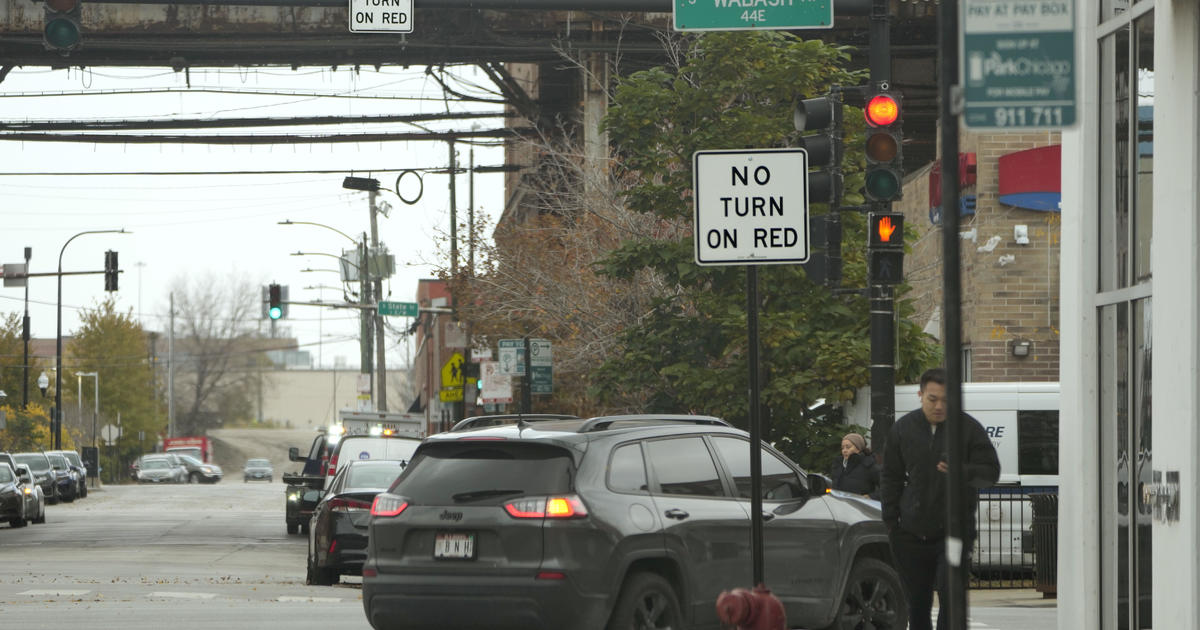Sophee Langerman was on her way to a bicycle safety rally in Chicago’s Lakeview neighborhood in June when a car turning right rolled through a red light and slammed into her bike, which she was walking off the curb and into the crosswalk.
The car was moving slowly enough that Langerman escaped serious injury, but the bicycle required extensive repairs. To Langerman, it’s another argument for ending a practice that almost all U.S. cities have embraced for decades: the legal prerogative for a driver to turn right after stopping at a red light.
A dramatic rise in accidents killing or injuring pedestrians and bicyclists has led to a myriad of policy and infrastructure changes, but moves to ban right on red have drawn some of the most intense sentiments on both sides.
Washington, D.C.'s City Council last year approved a right-on-red ban that takes effect in 2025. New Chicago Mayor Brandon Johnson’s transition plan called for “restricting right turns on red,” but his administration hasn’t provided specifics. The college town of Ann Arbor, Michigan, now prohibits right turns at red lights in the downtown area.
I live in one of these cities (Denver) and in my city’s case this push is part of a ton of other provisions including a push to set a maximum speed limit citywide of 25 mph.
About 80% of my trips out of the house are walking or on a bike, but it seems clear to me that policies like this don’t improve safety. It’s just lazy policy making. For example, if you set a 25 mph speed limit on a road designed to support 45 mph traffic, most drivers will still drive 45+ mph and you instead get a wild mismatch of driving speeds. This just slows traffic with an arguably negative benefit to safety. Similarly, if you ban turn on red in the city many drivers will still turn on red, but now whether or not a car will turn on red becomes unpredictable.
What our cities need is more dedicated bike and pedestrian infrastructure that is separated altogether from the roads, as well as greatly improved public transit.
Proper mass transit. Then pedestrian and bike paths are more useful.
After that, cars can go fuck themselves.
I live in Denver too and couldn’t agree more.
Yeah just like Oklahoma tried to ban driving through a yellow light they had to repeal that shit fast.
Cities cant suddenly change the turn on red when we were all taught we can. And if any city made the entire city 25mph I would avoid it like the plague and most companies that deliver good like truck drivers would either ignore it or boycott your town. Good luck with your supply chain issues.
“What’s really behind this movement is part of the agenda to make driving as miserable and as difficult as possible so people don’t drive so much,” Beeber said.
This is an unbelievably idiotic statement, as if cars haven’t been, and don’t continue to be nearly the sole consideration for transportation in almost all American cities.
I’m totally down for this. Right turn on red is optional, but people behind me seem to think it’s required and lay on their horns if I stop for more than a second. Like come on, I need a moment to make sure someone isn’t trying to cross!
I’m in favor of prioritizing safety, but if right on red is permitted, then it’s not optional. Just like going on green is not optional. Once you determine that you have the right of way you are expected to take it. This makes you predictable and safe.
Other drivers should be giving you a reasonable amount of time to determine your right of way though. You are also supposed to come to a full stop which should technically take about 3 seconds.
Right on red is most definitely optional. No need to be “predictable” in this situation - you’re coming to a full stop no matter what. How is not moving again unpredictable?
I’ve never heard of such a requirement. Where is that?
Here in Massachusetts, the law (MGL ch 89 sec 8) says: “At any intersection in which vehicular traffic is facing a steady red signal, the driver of a vehicle may make a right turn” (summarized, emphasis mine). May, not shall.
I read the full section, which is about right of way. It is consist with my prior statement. The summary you provided is the one that states that drivers have the right of way on red lights under certain conditions.
I mean, it’s pretty easy to not hit someone while turning right on red if you look where you’re going…
In a lot of cities, it’s extremely difficult to see past the corner because of parked cars. We could cut down on street parking, but people scream if you even consider restricting their parking options.
Especially when those parked vehicles are trucks or SUVs or some other unsafe large vehicle.
I mean I have a hate boner for giant cars as much the average person, but even a reasonably-sized, economy sedan can block my view of the sidewalk/any cars that might be coming around the corner. I would say it’s a 50% chance in my city that, in order to safely turn right on red, I’d need to inch about halfway into the lane I’m turning into, which already has the potential of causing an accident.
The spike, which included all accidents — not just those involving right turns on red, was attributed in part to an increase in larger vehicles such as SUVs and pickup trucks on the road … due to larger blind spots and the deadlier force associated with heavier models.
There it is, this is just one reason why ‘no right turns’ will be a useless half measure, politicians trying to make it look like they’re doing something about the problem because the real solution would be too politically risky.
When I visited the US I was shocked that’s actually allowed. Seemed like a very easy way to kill someone
It’s the “cars above all” mentality.
That said my city is doing this for bicycles which is way more reasonable.
I couldn’t work out how you were supposed to negotiate it as a pedestrian, and assumed there must be some knack that locals learn. Guess the knack is just, don’t be a pedestrian lol.
My own anecdotal evidence, walking several blocks and crossing a busy intersection everyday.
I take attempts to not get hit by looking at the driver and checking to see if they are paying attention. Often a driver will inch forward until they can time turning between cars coming from the opposite side of the intersection or will turn immediately when the light changes. I often have people who wait, but mostly people will just drive past me while I stand waiting to cross.
Car size doesn’t seem to make any difference in how aware the driver is or if they are following driver safety, at least when I’m attempting to keep myself from being hit.
It less serious than this but on my drive home there is this spot with 4 car lengths between stop lights and people with trailers keep taking it as free right to get into the middle of 3 northbound lanes blocking off the far right lane for turning right at the next light
If there isn’t other cross traffic, I’m going no matter what. In MA, we can even take a left on red onto a one way.
Huge majority of lighted intesections could be replaced with roundabouts/rotaries/traffic circles. Cars should not have to sit at idle if nothing is in the way.








